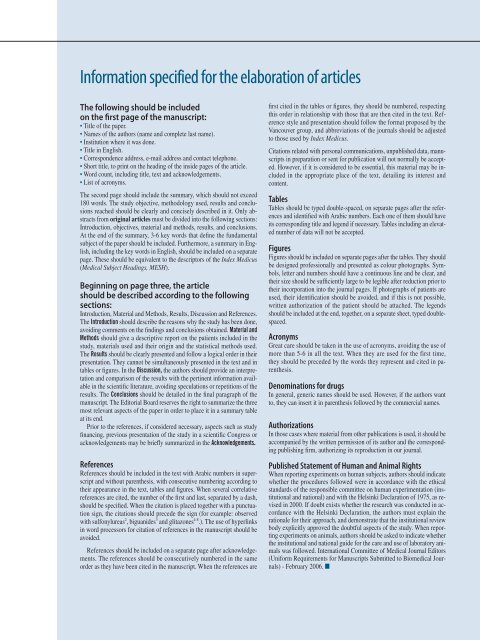AVD%2026(1)
AVD%2026(1)
AVD%2026(1)
You also want an ePaper? Increase the reach of your titles
YUMPU automatically turns print PDFs into web optimized ePapers that Google loves.
Information specified for the elaboration of articles<br />
The following should be included<br />
on the fi rst page of the manuscript:<br />
• Title of the paper.<br />
• Names of the authors (name and complete last name).<br />
• Institution where it was done.<br />
• Title in English.<br />
• Correspondence address, e-mail address and contact telephone.<br />
• Short title, to print on the heading of the inside pages of the article.<br />
• Word count, including title, text and acknowledgements.<br />
• List of acronyms.<br />
The second page should include the summary, which should not exceed<br />
180 words. The study objective, methodology used, results and conclusions<br />
reached should be clearly and concisely described in it. Only abstracts<br />
from original articles must be divided into the following sections:<br />
Introduction, objectives, material and methods, results, and conclusions.<br />
At the end of the summary, 3-6 key words that de ne the fundamental<br />
subject of the paper should be included. Furthermore, a summary in English,<br />
including the key words in English, should be included on a separate<br />
page. These should be equivalent to the descriptors of the Index Medicus<br />
(Medical Subject Headings, MESH).<br />
Beginning on page three, the article<br />
should be described according to the following<br />
sections:<br />
Introduction, Material and Methods, Results, Discussion and References.<br />
The Introduction should describe the reasons why the study has been done,<br />
avoiding comments on the ndings and conclusions obtained. Material and<br />
Methods should give a descriptive report on the patients included in the<br />
study, materials used and their origin and the statistical methods used.<br />
The Results should be clearly presented and follow a logical order in their<br />
presentation. They cannot be simultaneously presented in the text and in<br />
tables or gures. In the Discussion, the authors should provide an interpretation<br />
and comparison of the results with the pertinent information available<br />
in the scienti c literature, avoiding speculations or repetitions of the<br />
results. The Conclusions should be detailed in the nal paragraph of the<br />
manuscript. The Editorial Board reserves the right to summarize the three<br />
most relevant aspects of the paper in order to place it in a summary table<br />
at its end.<br />
Prior to the references, if considered necessary, aspects such as study<br />
nancing, previous presentation of the study in a scienti c Congress or<br />
acknowledgements may be brie y summarized in the Acknowledgements.<br />
References<br />
References should be included in the text with Arabic numbers in superscript<br />
and without parenthesis, with consecutive numbering according to<br />
their appearance in the text, tables and gures. When several correlative<br />
references are cited, the number of the rst and last, separated by a dash,<br />
should be speci ed. When the citation is placed together with a punctuation<br />
sign, the citations should precede the sign (for example: observed<br />
with sulfonylureas 2 , biguanides 3 and glitazones 4-8 .). The use of hyperlinks<br />
in word processors for citation of references in the manuscript should be<br />
avoided.<br />
References should be included on a separate page after acknowledgements.<br />
The references should be consecutively numbered in the same<br />
order as they have been cited in the manuscript. When the references are<br />
rst cited in the tables or gures, they should be numbered, respecting<br />
this order in relationship with those that are then cited in the text. Reference<br />
style and presentation should follow the format proposed by the<br />
Vancouver group, and abbreviations of the journals should be adjusted<br />
to those used by Index Medicus.<br />
Citations related with personal communications, unpublished data, manuscripts<br />
in preparation or sent for publication will not normally be accepted.<br />
However, if it is considered to be essential, this material may be included<br />
in the appropriate place of the text, detailing its interest and<br />
content.<br />
Tables<br />
Tables should be typed double-spaced, on separate pages after the references<br />
and identi ed with Arabic numbers. Each one of them should have<br />
its corresponding title and legend if necessary. Tables including an elevated<br />
number of data will not be accepted.<br />
Figures<br />
Figures should be included on separate pages after the tables. They should<br />
be designed professionally and presented as colour photographs. Symbols,<br />
letter and numbers should have a continuous line and be clear, and<br />
their size should be suf ciently large to be legible after reduction prior to<br />
their incorporation into the journal pages. If photographs of patients are<br />
used, their identi cation should be avoided, and if this is not possible,<br />
written authorization of the patient should be attached. The legends<br />
should be included at the end, together, on a separate sheet, typed doublespaced.<br />
Acronyms<br />
Great care should be taken in the use of acronyms, avoiding the use of<br />
more than 5-6 in all the text. When they are used for the first time,<br />
they should be preceded by the words they represent and cited in parenthesis.<br />
Denominations for drugs<br />
In general, generic names should be used. However, if the authors want<br />
to, they can insert it in parenthesis followed by the commercial names.<br />
Authorizations<br />
In those cases where material from other publications is used, it should be<br />
accompanied by the written permission of its author and the corresponding<br />
publishing rm, authorizing its reproduction in our journal.<br />
Published Statement of Human and Animal Rights<br />
When reporting experiments on human subjects, authors should indicate<br />
whether the procedures followed were in accordance with the ethical<br />
standards of the responsible committee on human experimentation (institutional<br />
and national) and with the Helsinki Declaration of 1975, as revised<br />
in 2000. If doubt exists whether the research was conducted in accordance<br />
with the Helsinki Declaration, the authors must explain the<br />
rationale for their approach, and demonstrate that the institutional review<br />
body explicitly approved the doubtful aspects of the study. When reporting<br />
experiments on animals, authors should be asked to indicate whether<br />
the institutional and national guide for the care and use of laboratory animals<br />
was followed. International Committee of Medical Journal Editors<br />
(Uniform Requirements for Manuscripts Submitted to Biomedical Journals)<br />
- February 2006. ■



